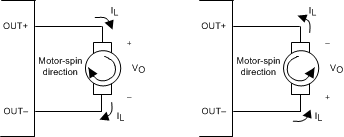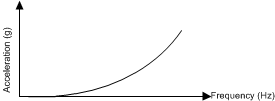SLOA207A November 2014 – November 2021 DRV2603 , DRV2604 , DRV2604L , DRV2605 , DRV2605L , DRV2624 , DRV2625
2.1 Eccentric Rotating-Mass (ERM) Actuators
Eccentric rotating-mass motors (ERMs) are typically DC-controlled motors of the bar or coin type. ERMs can be driven in the clockwise direction or counter-clockwise direction depending on the polarity of voltage across the two pins. Bidirectional drive can be made possible in a single-supply system by differential outputs that are capable of sourcing and sinking current. By switching driving directions, it is possible to "brake" the actuator, which helps eliminate long vibration tails which are undesirable in haptic feedback systems.
 Figure 2-1 Motor Spin Direction in ERM Motors
Figure 2-1 Motor Spin Direction in ERM MotorsERssM's are brushed DC motors; the commutation happens mechanically through the brushes, making the electronics relatively easy to design and implement; a simple DC voltage or PWM signal can be used. In the case of a PWM, the duty-cycle will be proportional to the vibration strength. However, the presence of brushes requires additional power consumption for a given vibration strength, and tend to wear out with use, impacting reliability.
ERM actuators also show a relationship between vibration strength and the angular frequency. This characteristic implies that the only way to achieve a particular acceleration is by having a particular angular frequency. A typical acceleration versus frequency profile is shown in Figure 2-2. This property is one that gives the ERM's its distinctive feel.
 Figure 2-2 ERM Acceleration Versus Frequency Response
Figure 2-2 ERM Acceleration Versus Frequency ResponseGiven the mechanical properties of ERM actuators, they are intrinsically slow, so transitions between a rest state and a moving state (and vice versa) may take a noticeable amount of time. To overcome the inertia of the mass of the actuator, these actuators are often overdriven for a short amount of time before going to the rated voltage of the motor to sustain the rotation of the motor. Overdrive is also used to stop (or brake) a motor quickly. Refer to the data sheet of the actuator for safe and reliable overdrive voltage and duration.